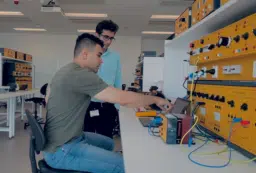Some forms of noise can actually improve your hearing, University of South Australia researcher, Mark McDonnell has found.
And he and the international research team with which he works hope to apply this result to develop more effective bionic ears.
McDonnell used mathematical tools to model the workings of the inner ear.
By doing so he was able to explain how random fluctuations of the sensitive hair cells-where sound vibrations are turned into electrical nerve impulses-help the brain to analyse sound.
These fluctuations produce electronic noise in the nerve system, and ensure that different nerves are triggered by different thresholds and characteristics of sound.
“This natural variability present in healthy ears is missing in patients with cochlear implants,” McDonnell says.
“We think implants could be improved by deliberate introduction of random electronic noise, so that neurons are stimulated in a biologically more realistic way.”
Digital sensors such as the microphones in bionic ears code sound volume into a scale of say one to 1000, McDonnell says. But biological systems made up of sensitive cells do not have the same capacity for coding rapidly changing volumes, like those in speech or music, directly onto such a fine scale. Instead, volume is measured by groups of identical nerve cells that can only individually rate sounds as loud or soft.
“It takes the unpredictable behaviour of each individual neuron for the group to code loudness to a greater accuracy,” McDonnell explains. “It’s like the brain asks groups of neurons for a yes or no vote on whether a sound is loud, and uses the number of yes votes as its measure of the volume.
“Without electronic noise in the system, all the cells would vote the same way, and the brain might as well only poll one of them. With it, any nerve cell could swing either way, but the louder the sound, the more likely any one cell is to vote yes.” Although the vote will be unpredictable and might occasionally miss the mark, McDonnell says that this is more than compensated for by having a code with a finer scale than simply ‘loud or soft’.
While McDonnell, and British colleagues led by Nigel Stocks of the University of Warwick think their research could improve cochlear ear implants, there is a catch. “The idea won’t work unless implants can produce fluctuations that are as different as possible across all neurons, and there are technical difficulties with this,” McDonnell says.
The team is currently developing an idea to overcome this problem. If successful, they hope it could lead to improved perception of music which is currently relatively poor with bionic ears.
Mark McDonnell is one of 16 early-career scientists presenting their research to the public for the first time thanks to Fresh Science, a national program sponsored by the Federal and Victorian Governments.
- For further information, contact Mark McDonnell at mark.mcdonnell@unisa.edu.au





 Fresh Science is on hold for 2022. We will be back in 2023.
Fresh Science is on hold for 2022. We will be back in 2023.